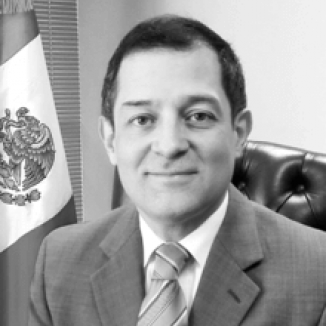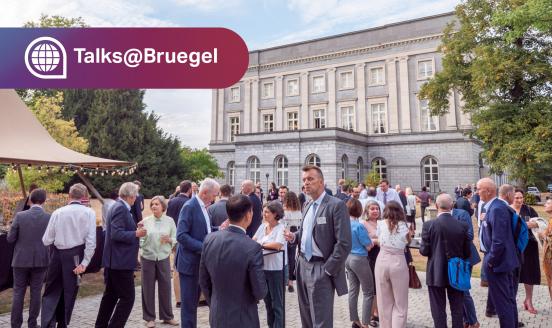EU-LAC Economic Forum 2019: New perspectives in turbulent times
The third edition of the EU-LAC Economic Forum.

Speakers
Maria Demertzis
Senior fellow
Bert Hoffmann
Head of Berlin Office, German Institute of Global and Area Studies (GIGA),
Edita Hrdá
Managing Director Americas, European External Action Service (EEAS),
Carlos Malamud
Senior analyst, Elcano,
Juan Jung
Director of Public Policy, ASIET - Asociación Interamericana de Empresas de Telecomunicaciones,
Ignacio Corlazzoli
Representative for Europe and Israel, IDB, Inter- American Development Bank,
Tobias Lenz
Senior Research Fellow, German Institute of Global and Area Studies (GIGA),
Matthias Jorgensen
Head of Unit Latin America, DG TRADE, European Commission,
Belén Romana
Non-executive Director, Santander and Aviva; Chair of the Board, Digital Future Society,
Diego Acosta Arcarazo
Reader, European and Migration Law, University of Bristol,
Carmen González Enríquez
Senior Analyst, Elcano Royal Institute,
Mauricio Escanero Figueroa
Head of the Mission of Mexico to the European Union and Ambassador to the Kingdom of Belgium and the Grand Duchy of Luxembourg,
video & audio recordings
SUMMARY
Introduction and Keynote speech
In a rapidly transforming world characterized by the growing Chinese leadership, new trade war and erosion of multilateralism, the EU and Latin American countries are facing new challenges. At this event, Bruegel fellows and panellists from international organizations discuss the evolution of EU-LAC ties.
Elena Pisonero provides an overview over the global situation. She stresses the importance of Spanish and European investments in South America. But also the issue of the leadership: 75 years after the D-Day and the establishment of the Pax Americana we are now witnessing significant changes. The US seems to be keen to relinquish the role of guarantor of the global order. At the same time, we are witnessing the rise of China, to which no country is able to oppose. China has strengthened its military ties with Russia and seduced various European countries through its Belt and Road initiative. Furthermore, Africa-China and Latin America- China trade has considerably increased. That is, China is the global player that has best taken advantage from the new times. The US is powerful but lacking of a long-run strategy, while Europe is concerned with its internal problems.
Besides geopolitical transformation, technology rapidly evolves. The hybrid reality emerging from the fourth technological revolution transforms work. Personal information and Data are gradually replacing the traditional work. In this context, politics has not been able to understand this process and its consequences: workers are not only replaced by cheaper workers, but also and mainly by machines. To face these challenges, dimension is essential. Therefore alliances become the more and more important. This is the framework in which EU-LAC partnership should be strengthened.
Guntram Wolff underlines the increasing mistrust in the new American administration. This is explained by the rejection of key principles that have been crucial over the last decades.
Ignacio Corlazzoli presents macroeconomics data concerning Latin America. The countries in the region, with some exceptions, are showing good growth levels. The new trade war could significantly change these trends. However, the region, especially Brazil, is running large public deficit. This is concerning because much of the public expenditure is increasingly made for older generations (such as pensions) and not to invest in young generations.
Following these remarks he poses the question on who is going to take over the role of main partner of Latin America if neither the US nor Europe want to play this role in the future. China seems to have more chances than its competitors. This fact is proved by the massive investments the Chinese government has been doing in the region.
Then, the addresses the issue of migration and discusses some potential solutions to the Venezuelan migration crisis. Also, he describes some proposals that could improve internet access in Latin America. As regards regional integration, Ignacio Corlazzoli highlights that the EU should finalize the agreement with Mercosur: this could foster Latin American regional integration and modernize Mercosur economy.
Edita Hrdá asks what we can expect from EU-LAC relations in the future. A new relationship must be based on prosperity, democracy, resilience and effective global governance. On the basis of these principles, a solid cooperation on climate change, promotion of rule of law, investment, digital education and innovation must be established.
Guntram Wolff raises the question to what extent the Chinese presence in Latin America should be considered a minus or a plus, in light of the fact that China does not completely share the western traditional values. The speakers agree on the fact that, in the short term, it is good news because of massive investments. By contrast, in the long term it could turn into a threat.
Carlos Malamud stresses the importance of the Mercosur agreement (close to the conclusion) and existing association and cooperation agreements between Europe and the majority of Latin American countries. A more solid cooperation between the two regions could help face other modern challenges such as migration.
Session I - Global Compact for Migration and its impact on EU-LAC relations
In the introduction to the discussion, Mauricio Escanero Figueroa first explains what the Global Compact for Migration is. Through the debate on the Global Compact, all the countries have addressed the migration issue at the United Nations for the first time. The speaker emphasizes the fact that, on this occasion, the international community has not only reflected on the causes of the phenomenon. It has rather established a platform for action. Albeit not binding, this document includes guidelines for the countries willing to cooperate to tackle this complex challenge.
Also, he states that the new Mexican government has embraced this global compact and announced the comprehensive development plan. This plan has the purpose to address the root causes of migration. It is not only a national plan but aims to become a regional initiative. It relies on national efforts but hinges upon international agreements. In facts, this plan is open to the regional partners and also to Europe, with which Mexico shares key values. In his opinion, cooperation over migration is strategic for EU-Lac relations. The two regions consider the human rights at the centre of their values.
Carmen González Enríquez highlights that migration has become an issue not only for destination countries, such as European states, but also for origin countries. Venezuela is a clear example. Then she reviews the main steps of the process that led to the approval of the Global Compact on Migration. In so doing, she draws the attention on the non-binding nature of the Compact, which is not a treaty but an intergovernmental agreement. This is due to concerns from several governments that have seen the Compact as a threat to national sovereignty.
In line with these considerations, she underlines that the support for global compact on refugee was higher than the one for global compact on migration (that 41 countries did not support). This difference can be explained by the different approach by the US administration. Various other governments voted against the compact for internal reasons generally linked to the fact that the public opinion is increasingly opposing initiatives which encourage migration.
As regards the EU and the LAC countries, she argues that this compact is unlikely to significantly affect the EU-LAC relations. In fact, the compact deals mainly with the problem of how to avoid irregular migration. In particular, recommends the states to recognize rights to migrants regardless of whether they are regular migrants or not. However, mostly Latin American migrants arrive to Europe legally.
In her opinion, Europe should strive to attract qualified people from Latin America. Young professionals and students leaving Latin American countries generally prefer the US or Canada as destination. This occurs because Europe is not competitive enough on this front. Furthermore the EU is not doing anything to improve since it is more concerned about the migration from Africa.
Diego Acosta Arcarazo discusses three main points. First he argues that the Compact is not a global instrument. It is rather a regional instrument. Second, he rejects the idea according to which the global South has jointly pushed to the approval of the agreement. To support his statement, he notes that several countries from the South have not supported it formally. Finally, he examines the relation between the Global Compact and the emergence of new actors in South America. In this context he underlines the major role that the civil society and the Academia may play.
Maria Demertzis goes back to the non-binding nature of the compact and asks whether positive outcomes can be reached in such a framework. The speakers emphasize that the migration issue requires a multilateral cooperation to be addressed. Any national attempt have fewer chances to succeed. Nevertheless, at this stage, it is not possible to make the compact binding. This is the best that can be achieved. But this initiative can be a first step that leads to regional binding agreements. However, there are few chances to achieve a better international deal within the next ten years. In fact, migration is a very sensitive issue as Europe’s striving concerning refugee reallocation demonstrates.
In conclusions the panellists answer questions about topics ranging from the role played by the countries in the migration issue to the case of Venezuela.
Session II – A new type of regional integration?
In this session, chaired by Carlos Malamud, Senior Analyst for Latin America at the Elcano Royal Institute, three experts discuss a new type of regional integration.
Alicia Garcia-Herrero, Senior Fellow at Bruegel, discussed two key trade integration issues: China’s impact on regional trade patterns and WTO reforms. China has attempted to link Latin America to other regional integration projects through the Belt and Road Initiative, which affect Bolivia, Chile, Ecuador, Peru, Uruguay, and Venezuela, as well as the Asian Infrastructure Investment Bank (AIIB), for which Uruguay is already a member and several other countries perspective members. In terms of infrastructure, China is promoting the integration of Latin America.
EU aspirations for WTO reforms are somewhat different from the Latin American proposals. Aside from different stances on subsidies, digital trade, and agriculture, Latin America as a whole is inspired by China’s “emerging market status,” which encouraged them to pursue the same special treatment in the WTO. Although China is not the largest investor in Latin America, it is the largest lender. The point is that China’s interactions in Latin America, in particular trade relations and investment, deeply impact the region’s integration process.
Tobias Lenz, Senior Research Fellow at the German Institute of Global and Area Studies (GIGA), focuses on the institutional and structural issues that accompany Latin American regional integration. He focuses particularly on the Pacific Alliance (PA), which is more informal in nature, and mainly oriented towards the outside (specifically Asia-Pacific). Lenz believes that the Pacific Alliance is a promising tool, but that it is likely to change as it moves forward. The informal nature of the Pacific Alliance means that the mechanism is more flexible, has lower operational cost, and easier to preserve national sovereignty (i.e. it moves as fast as the slowest member among the four states is willing to proceed). The main disadvantage is that the success of the arrangement depends very much on the cohesiveness of the political group. To operate on the basis of non-binding agreements means that the presidents themselves have to agree on the basic ideas and purposes of the organization.
The second characteristic of the Pacific Alliance is that it is explicitly outward-oriented, based on a strategy of economic insertion via attracting FDI through trade agreements and trade liberalization (“nation-branding”). PA’s liberal economic outlook is valuable when economic protectionist policies are on the rise across the globe. In addition, the organization is relatively unaffected by the political turmoil in the region (e.g. the Venezuelan crisis). However, Lenz is doubtful that the PA’s cooperation profile is distinctive enough from other regional organizations to ensure its survival after the TPP is potentially resurrected. In order to continue serve its purpose, Lenz argues that the PA should change and become more institutionalized.
Matthias Jorgensen, Head of Unit Latin America at DG Trade, the European Commission, stresses the importance of regional integration of Latin America in the EU’s trade policy. EU’s Free Trade Agreement negotiations also take place with regional blocs instead of individual countries. Since 2016, there has been stronger interest in Mercosur to open up, seeing an agreement with EU as a possible channel to access markets and reform their economies. On the E.U.’s side, it’s clear that multilateral trade relations are in a real moment of crisis since 2017. There are interests in creating rule-based trade with Mercosur, which could be highly beneficial for both parties. A window of possible opportunity will close soon considering the elections in Argentina and Uruguay, but both sides need to make real political decisions soon in order to achieve a balanced, comprehensive, and ambitious agreement.
Session III - Facing the 5G challenge: what is next for EU-LAC collaboration?
J. Scott Marcus, Senior Fellow, chairs the session discussing the 5G challenge. He opens his remark by making the observation that getting high-speed, broad-band connectivity to people in the large cities on the coasts is a very different matter from getting connectivity to the interior. Beyond the difference in population distribution between Latin America and Europe, mobile connectivity plays a much bigger role in parts outside Europe and North America. 5G is a potentially transformative technology with strengths and weakness that are poorly understood and reflected in the public literature. 5G is really good for internet-of-things applications, factory technologies, high capacity; these are mostly useful in big cities. The deployment of such technologies poses challenges for public policy and the industry. Institutional rigidities collectively introduce transaction costs and depress deployment; there is clearly work to be done for the policy community in Latin America.
Belén Romana Garcia, Non-executive Director at Santander and Aviva, discusses the transitional divide, questions regarding deployment, urban vs. rural, and dematerialization. 80% of Latin American population live in urban cities, but there are real divides over the deployment of 5G. Currently 35% of connections are 4G in Latin America, and some predictions suggest that only 8% of connections will be 5G by 2025. 5G deployment for certain industries such as agriculture and mining could be sporadic, but the bulk of deployment is expected to be in urban centers. Network effects create dematerialization, with enormous benefits even for developing countries in Latin America. In addition, regulatory problems are severe in Latin America. In terms of geopolitics, only four companies worldwide produce the cells in 5G: Ericsson and Nokia in Europe, ZTE and Huawei in China, and Samsung in South Korea. China holds a unique advantage in countries like Brazil, where China is a major investor and trade partner. Garcia notes that Latin America should face the new reality where it is not winning the battle. The region should therefore be humble and pragmatic in the future.
Juan Jung, Director of Public Policy at ASIET, first notes the urgency in Latin America to spread 5G deployment in order to catch up with the rest of the world. Latin America has a historical productivity problem due to a production structure that is heavily dependent on natural resources. 5G provides a lot of opportunities for productivity gains, in particular in the manufacturing industry and services. However, there are also key economic issues that must be taken into account when considering 5G deployment. It needs to figure out the required investments, costs of spectrums, and returns on investments. Jung advocates important reforms in Latin America. Revenues from the telecom sector in Latin America rank among the lowest in the world. Most legal framework are outdated, with barriers in municipalities requiring attention. Heavy taxation in the telecom sector (51% more pressure than other industries) also discourages development. Latin America is hence in a complex scenario.
Investments required for 5G launch will depend mostly on spectrum and the continuation of current deployment of 4G and fiberoptic. From a public policy perspective, a lot of isolated areas need to be connected. There is a digital divide to close. There is also need for a technological mix, for instance satellites in the 5G ecosystem. New regulatory frameworks are required that are consistent with applying the principles of technological neutrality to regulations. Jung also argues that spectrum policy should not be a part of fiscal policy.
Notes by Francesco Castorina & Tianlang Gao


















